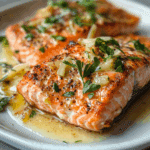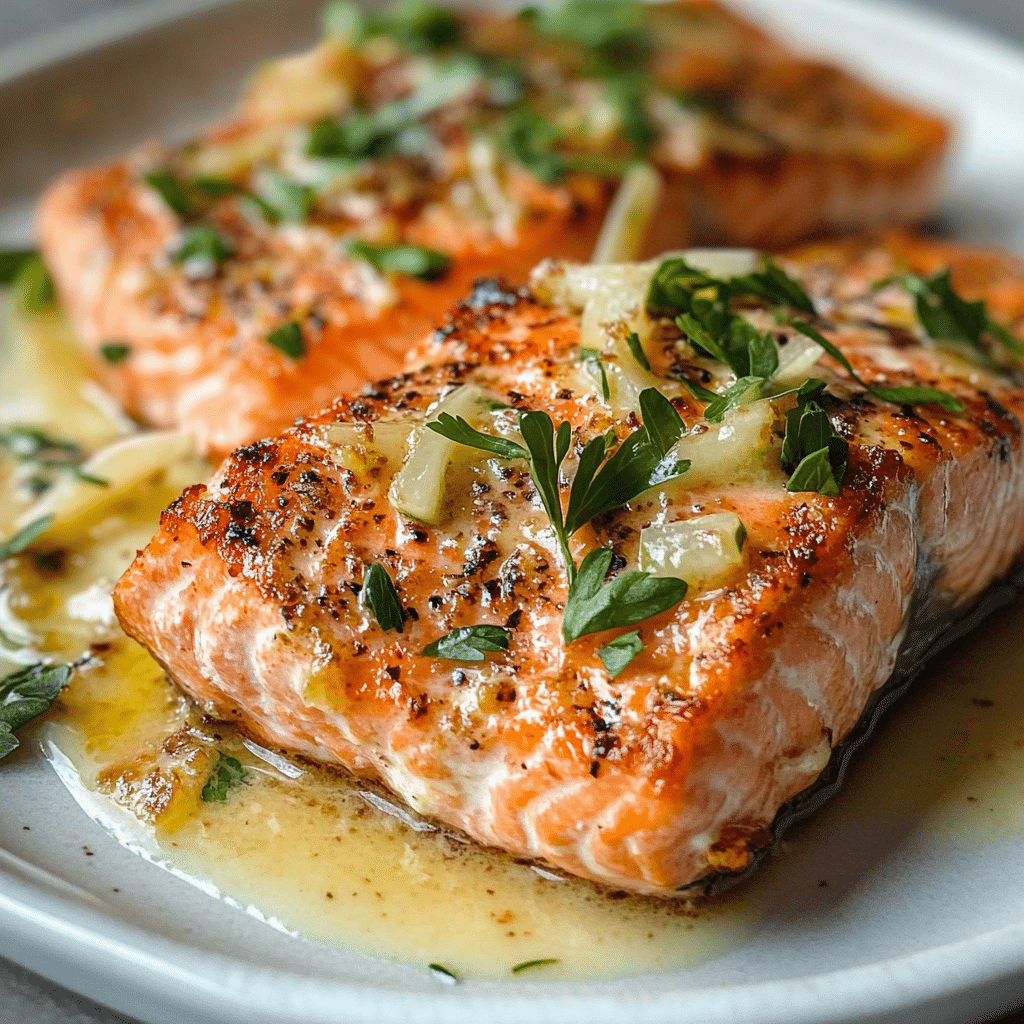If you’re craving a dish that combines a punch of bold flavor with healthful goodness, look no further than Horseradish Salmon. This vibrant recipe effortlessly blends the spicy kick of horseradish with the rich, buttery texture of salmon, creating a dish that’s not only quick and easy to prepare but also perfect for any dinner occasion. Whether you’re hosting guests or enjoying a weeknight meal, Horseradish Salmon delivers both taste and nutrition in every bite.
Why You’ll Love This Recipe
- Bold flavor profile: The horseradish infuses the salmon with a zesty heat that perfectly complements the fish’s natural richness.
- Quick preparation: This dish comes together in under 30 minutes, making it ideal for busy evenings.
- Healthy and nutritious: Packed with omega-3 fatty acids, this salmon recipe supports heart health and overall well-being.
- Versatile serving options: It works beautifully with a variety of sides, from fresh salads to roasted vegetables.
- Impressively elegant: Easy enough for weeknights but fancy enough for guests, this recipe hits all the marks.
Ingredients You’ll Need
When it comes to Horseradish Salmon, simplicity in ingredients is key. Each item brings a distinct element to the dish, whether it’s flavor, texture, or color, ensuring a well-balanced plate without any fuss.
- Fresh salmon fillets: Choose skin-on, wild-caught if possible, for maximum flavor and moisture.
- Horseradish: Freshly grated or prepared horseradish delivers that sharp, spicy kick essential to the recipe.
- Greek yogurt or sour cream: Adds a creamy base that softens horseradish’s heat while keeping the dish light.
- Lemon juice: Brings brightness and acidity that awaken the flavors.
- Garlic: Provides depth and earthiness to balance the horseradish’s sharpness.
- Olive oil: Used to sear or bake the salmon, enhancing richness without overpowering.
- Salt and pepper: Simple seasoning that pulls all the flavors together crisply.
Variations for Horseradish Salmon
One of the joys of Horseradish Salmon is how easy it is to personalize based on what you like or what’s on hand. Here are some fun variations to inspire your next meal.
- Smoky twist: Add smoked paprika or chipotle powder to the horseradish spread for a smoky heat.
- Dill infusion: Incorporate fresh dill into the sauce for a fresh herbaceous note.
- Dairy-free version: Swap Greek yogurt with coconut yogurt or mayonnaise for those avoiding dairy.
- Gluten-free option: Naturally gluten-free, just be sure to check prepared horseradish for additives.
- Spicy extra: Mix in a dash of hot sauce or chili flakes for more heat intensity.
How to Make Horseradish Salmon
Step 1: Prepare the Horseradish Sauce
Start by mixing freshly grated horseradish with Greek yogurt or sour cream, then add minced garlic and a squeeze of lemon juice. Stir everything together until smooth and adjust salt and pepper to taste. This creamy sauce will later coat the salmon and infuse it with a vibrant flavor.
Step 2: Prep Your Salmon
Pat your salmon fillets dry with paper towels to ensure a nice sear or even cooking. Lightly brush the salmon with olive oil, then season with salt and pepper. This lays a flavor foundation while keeping the fish moist and tender.
Step 3: Apply the Horseradish Mixture
Generously spread the horseradish sauce all over the top of the salmon fillets. This layer acts as a flavorful crust during cooking and seals in the moisture, enhancing each bite with creamy, spicy goodness.
Step 4: Cook the Salmon
You can bake the salmon in a preheated oven at 400°F (205°C) for about 12-15 minutes or pan-sear it on medium heat for 4-5 minutes per side. Either method locks in flavors and gives you a flaky, tender finish.
Step 5: Rest and Serve
Let your Horseradish Salmon rest for a few minutes after cooking to allow juices to redistribute. Serve warm with your choice of sides and garnishes for a balanced, eye-catching plate.
Pro Tips for Making Horseradish Salmon
- Fresh horseradish is key: It offers a sharper, fresher flavor than jarred versions—try to grate it yourself if possible.
- Don’t overcook the salmon: Aim for medium doneness to keep the fish tender and juicy.
- Use skin-on fillets: Cooking with skin helps keep the salmon moist and adds a crispy texture when pan-seared.
- Adjust heat level: If you’re new to horseradish, start with less and add more as you develop your palate.
- Let the sauce sit: Prepare the horseradish mixture ahead of time and let the flavors meld for 10-15 minutes before using.
How to Serve Horseradish Salmon
Garnishes
Fresh herbs like parsley, chives, or dill make perfect garnishes, adding a burst of green freshness and a subtle aromatic touch that complements the horseradish’s zest.
Side Dishes
Pair Horseradish Salmon with roasted asparagus, garlic mashed potatoes, or a crisp cucumber salad. These sides balance the dish with a mix of textures and flavors that round out your meal beautifully.
Creative Ways to Present
For a fun twist, serve the salmon atop a bed of quinoa or wild rice, drizzle extra horseradish sauce on the plate for a gourmet touch, or wrap the fillets in lettuce leaves for a light, hand-held experience.
Make Ahead and Storage
Storing Leftovers
Keep any cooked Horseradish Salmon in an airtight container in the refrigerator for up to 2 days. This helps preserve texture and flavor while making it easy to enjoy again later.
Freezing
While fresh is best, you can freeze fully cooked salmon wrapped tightly in plastic wrap and foil for up to 3 months. Thaw overnight in the fridge before reheating.
Reheating
Reheat gently in a low oven or microwave on a reduced power setting to avoid overcooking and drying out the salmon. Adding a small splash of water or lemon juice can restore moisture.
FAQs
Is Horseradish Salmon spicy?
Horseradish Salmon has a distinctive sharpness and mild heat, but it’s more of a zing than overwhelming spiciness. You can easily adjust the amount of horseradish to suit your heat tolerance.
Can I use frozen salmon for this recipe?
Yes, frozen salmon works well as long as it’s fully thawed and patted dry before cooking to achieve the best texture and flavor absorption.
What if I don’t like horseradish?
If the taste of horseradish isn’t for you, try substituting with Dijon mustard or wasabi for a different yet complementary kick.
Is this recipe suitable for meal prep?
Absolutely! Horseradish Salmon holds up well in the fridge and can be combined with various sides, making it perfect for preparing ahead and enjoying during the week.
How do I get a crispy crust on the salmon?
Pan-searing the salmon skin-side down on medium-high heat with a little oil will help develop a deliciously crispy skin while keeping the horseradish topping intact.
Final Thoughts
Horseradish Salmon is one of those recipes you’ll find yourself coming back to again and again. It’s vibrant, easy, and healthy, with a satisfying blend of flavors that feels both comforting and exciting. Whether you’re an experienced cook or just starting out, this dish is sure to delight your taste buds and impress anyone lucky enough to share your table. Give it a try and watch it become your new favorite go-to dinner!
Related Posts
- Easy Grilled Chicken Souvlaki Recipes to Try
- Easy Orecchiette Pasta with Sausage Recipe
- Why Linguine with Clam Sauce Is a Must-Try Meal

Horseradish Salmon
- Total Time: 25 minutes
- Yield: 4 servings 1x
- Diet: Gluten Free
Description
Horseradish Salmon is a vibrant and healthy dish that combines the zesty heat of fresh horseradish with the rich, buttery texture of wild-caught salmon fillets. This recipe is quick and easy to prepare, cooking in under 30 minutes, making it perfect for weeknight dinners or elegant meals for guests. Packed with omega-3 fatty acids and bright flavors from lemon juice and garlic, Horseradish Salmon delivers a bold flavor profile that is both nutritious and satisfying.
Ingredients
Salmon and Seasoning
- 4 fresh salmon fillets (skin-on, about 6 ounces each, wild-caught if possible)
- 2 tablespoons olive oil
- Salt, to taste
- Black pepper, to taste
Horseradish Sauce
- 3 tablespoons freshly grated horseradish (or prepared horseradish)
- 1/4 cup Greek yogurt or sour cream
- 2 cloves garlic, minced
- 1 tablespoon fresh lemon juice
- Salt and black pepper, to taste
Instructions
- Prepare the Horseradish Sauce: In a bowl, mix freshly grated horseradish with Greek yogurt or sour cream. Add minced garlic and a squeeze of lemon juice. Stir until smooth. Season with salt and pepper to taste. This creamy sauce will coat the salmon and infuse it with vibrant flavor.
- Prep Your Salmon: Pat the salmon fillets dry with paper towels to ensure a good sear or even cooking. Lightly brush each fillet with olive oil, then season both sides with salt and pepper. This step enhances flavor and helps keep the salmon moist.
- Apply the Horseradish Mixture: Spread the horseradish sauce generously and evenly over the top of each salmon fillet, creating a flavorful crust that seals in moisture during cooking.
- Cook the Salmon: Choose your cooking method: bake the salmon in a preheated oven at 400°F (205°C) for 12-15 minutes, or pan-sear on medium heat for 4-5 minutes per side until the salmon is flaky and cooked to medium doneness.
- Rest and Serve: Allow the cooked salmon to rest for a few minutes to let the juices redistribute. Serve warm with your favorite sides and garnishes for a balanced and visually appealing meal.
Notes
- Use fresh horseradish when possible for the sharpest flavor; freshly grated is preferable over jarred.
- Avoid overcooking the salmon to maintain its tender and juicy texture.
- Cooking with skin-on fillets adds moisture and provides a crispy texture when pan-seared.
- Adjust the horseradish quantity according to your heat preference, starting with less if you are sensitive to spice.
- Let the horseradish sauce sit for 10-15 minutes before applying to meld flavors.
- Prep Time: 10 minutes
- Cook Time: 15 minutes
- Category: Main Course
- Method: Baking or Pan-Searing
- Cuisine: American
Nutrition
- Serving Size: 1 salmon fillet (6 ounces)
- Calories: 350 kcal
- Sugar: 1 g
- Sodium: 150 mg
- Fat: 22 g
- Saturated Fat: 4 g
- Unsaturated Fat: 18 g
- Trans Fat: 0 g
- Carbohydrates: 3 g
- Fiber: 0.5 g
- Protein: 34 g
- Cholesterol: 85 mg


